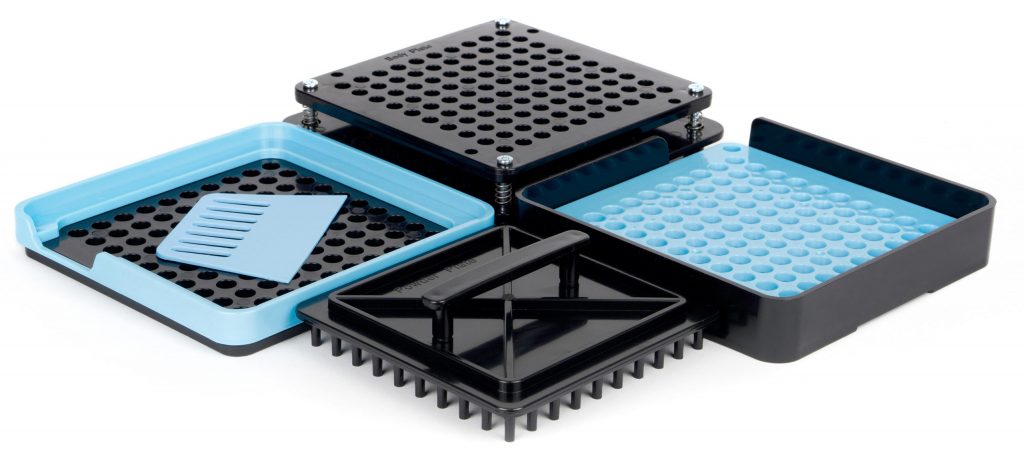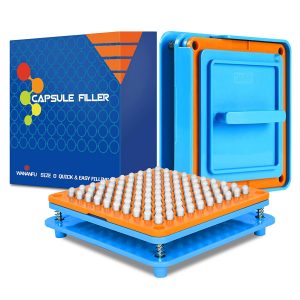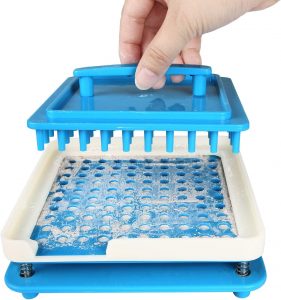Kapselfüller 00 Can Help You Make A Good Quality Capsule

If you’re looking to make your capsules, investing in a capsule filler can be a game-changer. Not only will it save you time, but it can also increase the accuracy and consistency of your capsule-filling process.
Capsule fillers come in many different types and sizes, but they all share the common goal of making it easier to fill capsules with your desired supplement or powder. One of the biggest benefits of using a capsule filler is the time-saving aspect. With a capsule filler, you can fill dozens of capsules in just a few minutes, whereas filling them manually could take hours.
Many capsule fillers are available in the market, ranging from manual to automatic fillers. Manual capsule fillers are typically more affordable and may be appropriate for smaller batches of capsules. They work by allowing you to load the capsules into the filler, fill them with powder, and then cap them with the other half of the capsule. Some manual fillers also come with accessories such as a spill guard and spreader card to make the filling process even easier.
Automatic capsule fillers, on the other hand, are more expensive but can greatly increase productivity. These machines fill the capsules automatically, and some can even sort and align the capsules to streamline the process further. It’s important to note, however, that automatic fillers may require a larger investment and more intensive maintenance.
Having a capsule filler at home can also be incredibly convenient. You can create customized capsules with your desired supplements and powders according to your individual needs. This can be particularly helpful for those with dietary restrictions, or for those who prefer to create their blends of herbs and supplements.

Types of Capsule Fillers
Capsule fillers are a convenient tool for filling capsules with your desired supplements or powders. If you’re in the market for a capsule filler, it’s important to consider the different types available and which one best suits your needs. From manual to automatic fillers, learn about the various types of capsule fillers in the following sections.
Manual Capsule Fillers
Manual capsule fillers are devices that help you fill your capsules with the desired quantity of your chosen supplement or powdered herb. There are several different types of manual capsule fillers available in the market today, each with its unique features and advantages.
One of the key benefits of using a manual capsule filler is that it allows for more accurate dosing compared to bare-hand filling techniques. Additionally, it reduces product waste by minimizing excess powder spillage that typically occurs with hand filling. Moreover, using manual capsule fillers is a more efficient method of filling capsules, saving you time and effort.
Manual capsule fillers come in different sizes, allowing users to fill capsules of various sizes, including 00, 0, 1, 2, 3, 4, 5, and even smaller size capsules. Depending on the type of manual filler, users can expect to fill anywhere between 20-800 capsules in a single batch, with larger machines capable of filling up to 450k capsules per batch.
The material of the manual capsule filler is also an essential factor to consider when choosing a manual capsule filler. It is essential to consider the manufacturing material as it can affect the durability and performance of the device. Most manual capsule fillers are made of plastics, acrylic, or metal, and it is essential to choose one that is durable and easy to clean.
Several manufacturers produce different types of manual capsule fillers. Cap-M-Quik, Capsu-Fill, and Capsule Connection are some of the most popular manufacturers. Some of the different types of manual capsule fillers available in the market include hand-operated capsule fillers, capsule machines with bases and holes, and handy capsule makers equipped with spreader cards and spill guards.
Automatic Capsule Fillers
Automatic capsule fillers are machines designed to fill capsules quickly and accurately, making them ideal for large-scale production. There are several types of automatic capsule fillers available in the market, each with its unique features and benefits.
The first type is the doctor-type filler, which uses a dosing disc to deliver a predetermined amount of powder or granular material into each capsule. This type is capable of filling up to 100,000 capsules per hour and is best suited for high-volume production.
The second type is the tamping pin type filler, which uses a tamping pin to compress the powder and ensure accurate dosing. This type is ideal for filling capsules with fine powders that are difficult to handle.
The third type is the rotary type filler, which uses rotating disks to fill capsules in a continuous process. This type is highly versatile and can handle different types of powders and granules.
Finally, there is the soft gel encapsulation machine, which is designed to fill soft gel capsules with liquid or semi-liquid materials. This type is best suited for the pharmaceutical and nutraceutical industries.
Each type of automatic capsule filler has its advantages and disadvantages. The doctor-type filler, for example, is fast and accurate but can be difficult to clean and maintain. The tamping pin type filler is highly accurate but can be expensive and time-consuming to set up. The rotary-type filler is highly versatile but can be sensitive to changes in powder density.
Some of the most reliable brands in the market include Bosch, IMA, and Capsugel. These machines are capable of filling anywhere from 10,000 to 700,000 capsules per hour, with a high degree of accuracy and precision. They also feature advanced controls and sensors for monitoring powder densities and ensuring consistent quality.
When choosing an automatic capsule filler, it is important to consider technical specifications such as throughput rate, accuracy, and powder densities. The throughput rate refers to the number of capsules the machine can fill in a given time, while accuracy refers to the degree of precision in dosing the powder. Powder densities refer to the density of the powder or granules being used and can affect the overall accuracy and performance of the machine.
Advantages of Different Types of Capsule Fillers
Capsule fillers are machines that allow users to create their own filled capsules for a wide range of purposes, including medicinal, dietary, and herbal supplements. There are two main types of capsule fillers, manual and automatic, each with its own set of advantages depending on the user’s needs.
Manual capsule fillers are ideal for home use, particularly for those who require smaller batches of filled capsules. These filters are affordable, easy to clean and maintain, and provide an adjustable filling capacity, allowing users to accurately measure out the desired amount of herbs or powders for a custom blend. Manual fillers are also highly portable and compact, requiring minimal storage space and making them a great choice for those who travel or have limited workspaces.
On the other hand, automatic capsule fillers are better suited for more commercial purposes where larger batches of capsules are needed. Automatic capsule fillers are efficient, capable of filling hundreds of capsules in just a few minutes, providing a hassle-free and less time-intensive process. They also offer greater accuracy in measuring the amount of powder or granules used per capsule, which is critical for ensuring consistent quality in production.
There are different types of automatic capsule fillers, each with its own set of advantages. The doctor-type filler is known for its speed and accuracy, filling up to 100,000 capsules per hour with minimal waste. The tamping pin-type filler is ideal for filling capsules with fine powders that are difficult to handle, while the rotary-type filler is versatile and can handle different types of powders and granules. Finally, the soft gel encapsulation machine is designed to fill soft gel capsules with liquid or semi-liquid materials, which is particularly useful in the pharmaceutical and nutraceutical industries.
Components of a Manual Capsule Filling Machine
A manual capsule-filling machine is an essential tool for those who require smaller batches of filled capsules. It is easy to use, and maintain and provides adjustable filling capacity for accurate measurements. To help you understand the different components of a manual capsule-filling machine, read on.

The base of the Machine
The base of the capsule filling machine is a crucial component that helps in the efficient filling of your good quality capsules. In a manual capsule filling machine, the base is typically made of sturdy and durable plastic material, which can withstand the wear and tear of regular use.
The main function of the base is to provide a secure and stable platform for the capsules to be filled. The bottom halves of the capsules are held firmly in place while the user fills the top halves with the desired contents. This ensures that the capsules are filled accurately and consistently in each batch.
The size of the base can vary depending on the size of the machine and the number of capsules that can be loaded into it at once. Typically, the base of a manual capsule-filling machine can hold anywhere between 50 to 100 capsules, depending on the size of the machine and the needs of the user.
It’s important to note that the base should fit snugly on a flat surface to ensure optimal performance. This is especially important when filling capsules with different densities or powders, as any instability or shifting of the machine can result in uneven filling and inaccurate dosing.
Spill Guard/Spreader Card
When it comes to filling your capsules using a manual capsule-filling machine, preventing excess powder from spilling is of utmost importance. That’s where the Spill Guard or Spreader Card comes in handy.
The Spill Guard is a small, flat piece of plastic or metal that fits over the empty capsule bodies in the base of the machine. It may seem like a small detail, but it can make a world of difference in improving efficiency and reducing cleaning time during the capsule-filling process.
One of the greatest benefits of using a Spreader Card is that it makes filling capsules much easier. It creates a smooth and even surface on which to spread the ingredients, which helps to ensure that the powder is evenly distributed throughout each capsule.
To use the Spill Guard, simply pour the desired amount of ingredients into the base of the machine without creating any heap or ridge. Next, place the Spill Guard over the base and move it from side to side to distribute the powder evenly into each of the capsule bodies.
Not only does the Spill Guard make filling capsules easier and more efficient, but it also helps to prevent excess powder from spilling all over your workspace. By using a Spreader Card, you can be confident that each capsule is filled accurately and consistently, without wasting any of your valuable ingredients.
Holes for Filling the Powder into the Capsules
Kapselfüller 00 come in different sizes, and each type has holes of different sizes to fill different types of capsules. Generally, manufacturers produce two types of capsules – gelatin capsules and vegetarian capsules, and each type usually corresponds to a specific size of the holes on the filler machine.
When filling capsules, the first step is to determine the appropriate hole size based on the capsule size. For instance, capsule filler machines that are designed to fill 00-size capsules will have holes that are slightly larger than the holes on a machine that is designed to fill size 0 capsules.
Another important factor to be aware of is the density of the powder that you plan to fill into the capsules. Different types of powder will have different densities, which means that the amount of powder that can fit into a single capsule will vary. Therefore, it is crucial to weigh the powder and use a calculator or a scale to estimate how much powder you need to fill each capsule accurately.
During the filling process, it is common to experience excess powder particles that spill out of the capsule bodies. These spillages can cause delays and affect the quality of your product. However, you can easily avoid this by using a spreader card or a spill guard. A spill guard is a small flat piece of plastic or metal that fits over the empty capsule bodies in the base of the machine, while a spreader card is designed to create a smooth and even surface for spreading the ingredients throughout each capsule.
The capsule machine base is an essential component of the filling process, and it houses the capsule halves. After properly aligning the empty capsules in the base, you can then pour the desired amount of ingredients into the powder-spreading surfaces of the machine.
Compartments for Holding Finished or Unfilled Capsules
When using a manual capsule-filling machine, it’s essential to have compartments designed to hold finished or unfilled capsules. These compartments are often separate, with one section holding the capsule bodies, and the other section holding the capsule caps.
The use of separate compartments makes it easier to assemble the filled capsules as you can quickly pick out one cap and one body and put them together. Once the capsule machine is filled with the necessary capsules, carefully transfer them to the storage compartments.
It’s crucial not to tamper with the capsules during the process to avoid any spillage of contents. These compartments make it easier to manage the capsules and keep them organized, reducing the risk of spilling and helping to maintain the quality of the finished product.
So, if you’re looking to make your capsules, a manual capsule-filling machine with compartments for holding finished or unfilled capsules is an excellent investment. With this feature, you can ensure that you’re properly assembling the capsules and storing them in an organized and efficient manner.
Storage for Excess Powder After Filling the Capsules
When filling capsules, it is normal to have excess powder left over. Properly storing this excess powder is crucial to maintain its quality and make sure it remains usable for future batches.
Most capsule-filling machines come with a designated compartment where the excess powder can be stored. Carefully transfer the leftover powder from the capsule machine into this compartment, making sure that you don’t spill any of it.
Before handling the excess powder, it’s important to use a clean measuring spoon or spatula. This ensures that the powder doesn’t get contaminated with other substances or powders that might be leftover on dirty utensils.
Once you have transferred the excess powder to the designated compartment, make sure to store it in an airtight container. This will protect the powder from moisture and air, which could alter its properties and make it unusable for future batches.
It’s also important not to mix different powders when storing excess powder. Even if they look very similar, different powders can have different properties that could cause them to react unfavorably with each other.
By following these steps, you can properly store excess powder and maintain the quality of your powders for future batches.
Conclusion
In conclusion, using a capsule-filling machine can greatly benefit different individuals such as fitness enthusiasts looking to create their supplements, entrepreneurs wanting to start their own supplement business, and research and development departments needing to test new formulas. By using a capsule-filling machine, individuals have greater control over the quality and quantity of their capsules.








